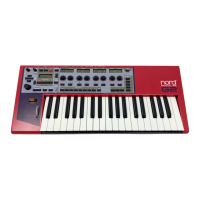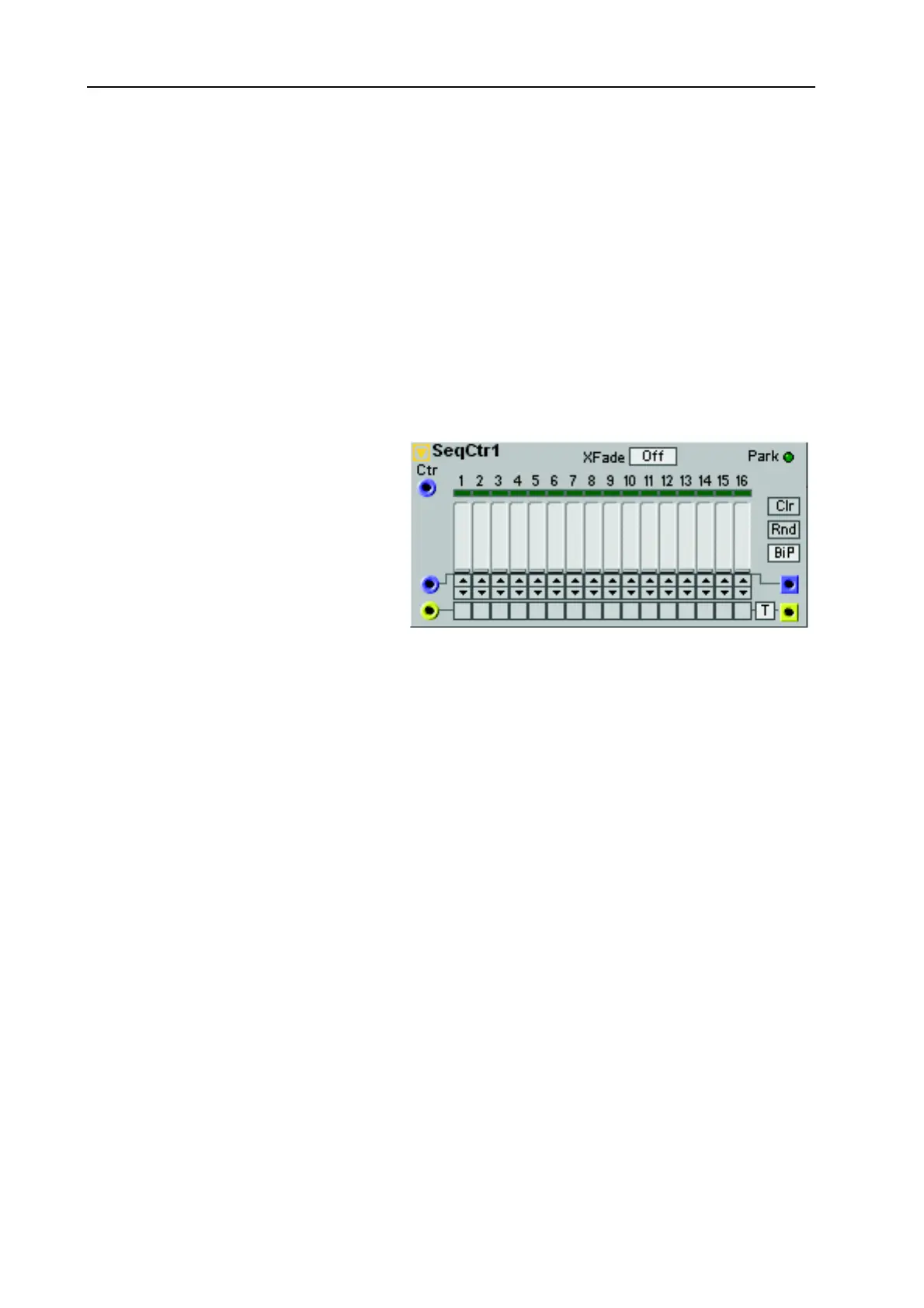11. Module reference: Sequencer group NORD MODULAR G2 V1.1
Page 184
each step by clicking on the desired “key” in the window. Where in the total keyboard range the notes
are placed is determined with the Magnifier and Octave selector described below. I note values should be
outside the currently visible keyboard range, these will be indicated by triangular arrows in the window.
M
MM
M
A
AA
AG
GG
GN
NN
NI
II
IF
FF
FI
II
IE
EE
ER
RR
R
Click on the Magnifier to select the visible keyboard range in the Note Sequencer between 1, 2 and 3
octaves. Note that if you click the Rnd button to randomly distribute note values, the notes will be dis-
tributed only within the range selected with the Magnifier control.
O
OO
O
C
CC
CT
TT
TA
AA
AV
VV
VE
EE
E
S
SS
SE
EE
EL
LL
LE
EE
EC
CC
CT
TT
TO
OO
OR
RR
R
Click the Octave selector to select the highest note in the Piano roll window. Range: C0-C7. See also
"Common Sequencer parameters”.
S
SS
S
E
EE
EQ
QQ
Q
C
CC
C
T
TT
TR
RR
R
The Control Sequencer is special in the
way that instead of controlling the step
advancement by incoming clock pulses,
they are controlled by incoming control
signal values. This makes it possible to
control the step advancement, and di-
rections, totally freely. There is also a
row of Step buttons for sending out a
Trig/Gate signal for every step in the se-
quence.
C
CC
C
T
TT
TR
RR
R
I
II
IN
NN
NP
PP
PU
UU
UT
TT
T
The Dynamic Control/Audio signal input for controlling the step numbers. The steps respond to the
following input signal values: Step 1: 0 to <4, Step 2: 4 to <8, Step 3: 8 to <12, Step 4: 12 to <16, Step
5: 16 to <20, Step 6: 20 to <24, Step 7: 24 to <28, Step 8: 28 to <32, Step 9: 32 to <36, Step 10: 36 to
<40, Step 11: 40 to <44, Step 12: 44 to <48, Step 13: 48 to <52, Step 14: 52 to <56, Step 15: 56 to <60
and Step 16: 60 to 64.
Example: To simulate the behavior of a “regular” clock-synched sequencer, patch a positive unipolar in-
verted sawtooth LFO signal at full range to the Volt input.
XF
XFXF
XF
A
AA
AD
DD
DE
EE
E
S
SS
SC
CC
CR
RR
RO
OO
OL
LL
LL
LL
L
B
BB
BU
UU
UT
TT
TT
TT
TO
OO
ON
NN
N
Another special feature of the Volt Sequencer module is the ability to crossfade in a linear fashion between
values of adjacent steps. Click the XFade scroll button to select degree of crossfade. Values: Off, 25%,
50% and 100%. See also "Common Sequencer parameters”.
S
SS
S
E
EE
EQ
QQ
QU
UU
UE
EE
EN
NN
NC
CC
CI
II
IN
NN
NG
GG
G
E
EE
EX
XX
XA
AA
AM
MM
MP
PP
PL
LL
LE
EE
ES
SS
S
G
GG
G
E
EE
EN
NN
NE
EE
ER
RR
RA
AA
AL
LL
L
I
II
IN
NN
NF
FF
FO
OO
OR
RR
RM
MM
MA
AA
AT
TT
TI
II
IO
OO
ON
NN
N
• Gate or trigger the envelopes in the patch with something if you want the sequencer to play notes. If
you are using every step in the sequence, you can use the same clock source as a trigger for the enve-
lopes, as well as the clock source for the sequencer modules. A more versatile way is to gate/trig the
envelope from use the sequencer’s Trig/Gate output.

